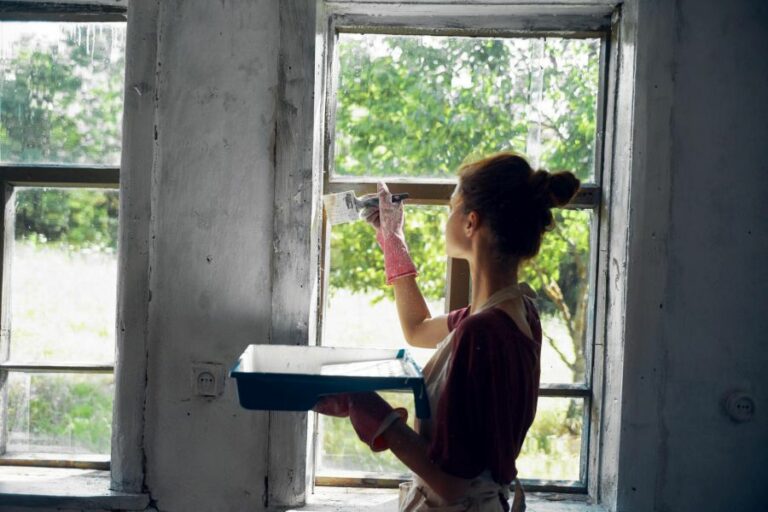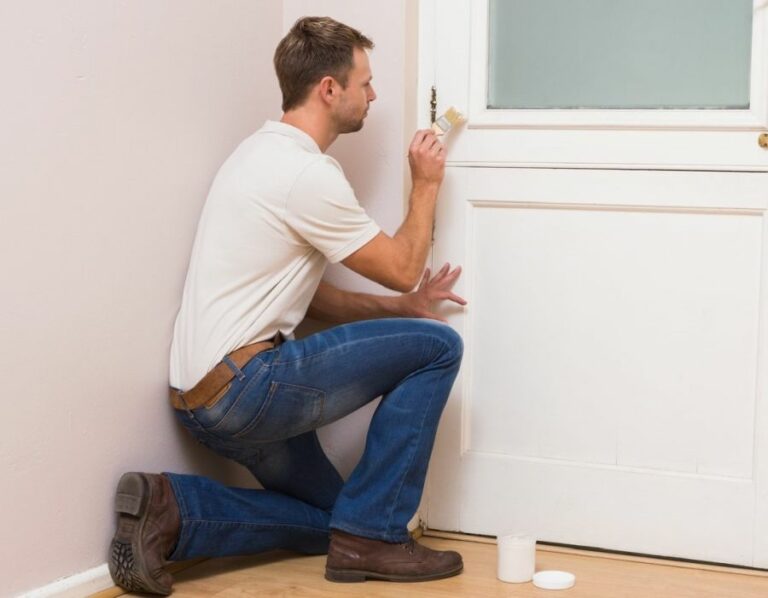Outdoor Cement Paint Colors, 25 Things You Should Know
Are you looking to refresh your exteriors and give your home a new look? Discover an extensive range of cement paint shades that enhance your property’s aesthetic and provide long-lasting protection against harsh weather conditions. Get inspired by our unique and trendy color palette that includes numerous options for all types of outdoor spaces.
Outdoor cement paint colors:
Outdoor cement paint colors significantly impact the aesthetics of exterior spaces. Popular paint types include acrylic, epoxy, latex, and alkyd paints, each offering unique benefits. Consider existing outdoor elements, nature-inspired colors, and light versus dark shades when choosing a color. Testing colors is essential. To ensure a successful painting project, prepare the surface, apply primer, use the right tools, apply multiple coats, and protect the painted surface with a sealer or clear coat. Proper planning and preparation can transform cement surfaces into beautiful, long-lasting features.

Discover the perfect outdoor cement paint colors to elevate your space, enhance curb appeal, and create a warm, inviting atmosphere. Learn about various shades, their unique benefits, and tips to choose the best hues to match your personal style.
Contents
- 1 Exterior Concrete Paint Color Options
- 2 Which Color of Paint is Most Suitable for Concrete Surfaces?
- 3 Which Kind of Paint is Most Suitable for Exterior Concrete Surfaces?
- 4 Is it advisable to apply paint on concrete surfaces?
- 5 Is there a paint option available in the color of concrete?
Exterior Concrete Paint Color Options
• Introduction to Outdoor Cement Paint Colors
Outdoor cement paint colors are an important aspect of enhancing the aesthetics of your outdoor spaces. Whether you are looking to refresh your driveway, enhance your patio, or give your home’s exterior walls a modern touch, choosing the right paint colors can make all the difference.
• Types of Outdoor Cement Paint Colors
Several types of outdoor cement paint colors are available in the market, catering to different requirements and preferences. Some of the most popular types include:
– Acrylic Paints
Acrylic paints are water-based and offer a wide range of colors. They are ideal for cement surfaces as they are durable, easy to apply, and have excellent resistance to weathering and UV rays.
– Epoxy Paints
Epoxy paints are known for their strong adhesion and chemical resistance, making them suitable for indoor and outdoor cement surfaces. These paints are available in various colors and come in two parts, resin and hardener, which must be mixed before application.
– Latex Paints
Latex paints are another popular option for outdoor cement surfaces. They are water-based and quick-drying, making them easy to apply and clean up. Additionally, they provide excellent resistance to UV rays, moisture, and weather changes.
– Alkyd Paints
Alkyd paints are oil-based paints that offer excellent durability and adhesion. They are suitable for outdoor cement surfaces, such as garage floors, driveways, and walkways, due to their resistance to wear and tear.
• Choosing the Right Color for Your Cement Surfaces
Selecting the right outdoor cement paint color can be daunting, but some tips can help guide your decision-making process.
– Consider Existing Elements
Take note of the existing elements in your outdoor space, such as your home’s exterior walls, fences, pathways, and landscaping. Pick a color that complements these elements and creates a cohesive and uniform look.
– Nature-Inspired Colors
Nature-inspired colors tend to be popular for outdoor cement surfaces. Earthy tones like browns, greens, and blues can create a harmonious look with your natural surroundings.
– Light vs. Dark Colors
Light colors can create a sense of openness and space, while darker colors can provide a sense of warmth and sophistication. Consider the overall look you want to achieve before deciding on the paint color.
– Test the Colors
Before committing to a color, buy small paint samples and test them on a small area of your cement surface. This will give you a better idea of how the color will look once applied and allow you to make any necessary adjustments.
• Painting Tips for Outdoor Cement Surfaces
To ensure a successful outdoor cement painting project, follow the tips below:
– Prepare the Surface
Clean and prepare the cement surface to ensure the paint adheres properly. Remove all dirt, debris, and loose paint flakes with a pressure washer or a stiff-bristle brush. Repair any cracks or holes with a concrete patching compound.
– Apply Primer
To ensure even coverage and a smooth paint finish, apply a suitable primer specially formulated for cement surfaces. This will also improve the paint’s adhesion and longevity.
– Choose the Right Tools
Select the appropriate tools and equipment for your painting project. Paint rollers, brushes, and sprayers can all provide good results when used correctly.
– Apply Multiple Coats
For a durable and even finish, apply multiple coats of paint, allowing each coat to dry before applying the next. It is important to follow the recommended drying times provided by the paint manufacturer.
– Protect the Painted Surface
Once the final coat has dried, protecting your newly painted cement surface from damage is essential. Apply a sealer or protective clear coat to provide additional protection from the elements.
• Conclusion
Outdoor cement paint colors are crucial in defining your outdoor spaces’ aesthetics.
By considering existing elements, opting for nature-inspired colors, and following practical painting tips, you can successfully transform your cement surfaces into beautiful and long-lasting features of your home.
Whether you are a seasoned DIY enthusiast or a novice painter, investing time in selecting the right paint and preparing your surface will ensure a successful outcome. Happy painting!
Which Color of Paint is Most Suitable for Concrete Surfaces?
Concrete is a versatile and durable material that is used in various applications, such as flooring, walls, and countertops. As a result, many homeowners and builders are faced with the challenge of choosing the right color paint for their concrete surfaces.
• Understanding Concrete Paints
Before diving into the best color options for concrete, it’s essential to understand the different types of concrete paints available. These paints are specially formulated to adhere to the porous nature of concrete surfaces and provide long-lasting results.
– Epoxy Paint
Epoxy paint is a popular choice for concrete flooring due to its durability and resistance to chemicals, stains, and heavy foot traffic. This paint is typically used in garages and basements, offering a glossy finish that is easy to clean.
– Acrylic Paint
Acrylic paint is a water-based paint suitable for both indoor and outdoor concrete surfaces. It is UV-resistant, making it an excellent choice for exterior applications such as patios and walkways. Acrylic paint dries quickly and provides a satin or semi-gloss finish.
– Masonry Paint
Masonry paint is designed specifically for concrete and other masonry surfaces. It contains binders that help it adhere to the porous material and provide a durable, weather-resistant finish. This paint is suitable for exterior applications and is available in a wide range of colors and finishes.
• Factors to Consider When Choosing the Best Color Paint for Concrete
Several factors can influence the choice of color paint for concrete surfaces. These include the purpose of the surface, surrounding design elements, and personal preference.
– Purpose of the Surface
The intended use of the concrete surface will significantly impact the choice of paint color. For example:
- For high-traffic areas such as garages or basements, choose dark shades that can conceal dirt and stains.
- In outdoor spaces like patios or walkways, opt for lighter colors that help to reflect heat and keep the surface cool.
- For artistic or decorative purposes, consider using multiple colors or even patterns to create an eye-catching design.
– Surrounding Design Elements
Consider the color scheme of the room or outdoor space when choosing a paint color for your concrete surface. Selecting a color that complements other design elements will create a cohesive and visually appealing aesthetic. For example:
- Choose a muted tone that works well with the existing colors in a room with a neutral color palette.
- For outdoor spaces surrounded by lush greenery or colorful flowers, consider a shade that complements or contrasts the natural environment.
– Personal Preference
Ultimately, the choice of paint color for your concrete surface is personal. Choose a color that makes you feel comfortable and reflects your style. Don’t be afraid to experiment with bold shades or unique designs. If you’re not sure about a color, try painting a small test area first to see how it looks.
• Best Color Options for Various Concrete Surfaces
Based on the factors mentioned earlier, here are some color recommendations for various concrete surfaces:
– Garage Floors
Consider colors like medium grey or charcoal for garage floors, which are prone to oil stains and dirt. These shades will help disguise dirt and complement the typical garage environment.
– Basement Floors
Opt for lighter shades such as sand or light grey for basement floors, where natural light may be scarce. These colors will help brighten the space and make it more open.
– Concrete Countertops
Consider earthy tones like beige, taupe, or terracotta for concrete countertops. These colors create a warm and natural appearance that works well with a variety of kitchen design styles.
– Outdoor Patios and Walkways
Choose lighter shades such as sand, light grey, or pale blue for outdoor concrete surfaces. These colors will reflect sunlight, helping to keep the surface cool during hot summer months.
– Decorative Concrete
For decorative concrete surfaces, the possibilities are endless. You can create custom designs using stencils and multiple colors. Bold shades like deep red, midnight blue, or forest green can add a dramatic flair to your space.
In conclusion, the choice of color paint for your concrete surface is essential, as it can enhance the aesthetics of your space and improve its functionality.
By considering factors such as the intended purpose of the surface, surrounding design elements, and personal preference, you can choose the best color for your project. Plus, exploring the various types of concrete paints available ensures a long-lasting and beautiful finish.
Color | Advantages | Disadvantages |
|---|---|---|
White | Reflects sunlight, keeps the surface cool | Shows dirt and stains easily |
Gray | Matches natural concrete color, hides dirt and stains | Can appear dull or monotonous |
Neutral tones (beige, sand, taupe) | Blends well with surroundings, hides dirt and stains | May require more frequent touch-ups due to fading |
Bright colors (blue, red, green) | Adds vibrancy and visual interest | May fade faster under sunlight, more difficult to match with surroundings |
Dark colors (black, dark brown) | Hides dirt and stains, can create a striking visual contrast | Absorbs sunlight and heat, may cause the surface to become hot |
Which Kind of Paint is Most Suitable for Exterior Concrete Surfaces?
When it comes to painting exterior concrete surfaces, homeowners generally have two major concerns: durability and aesthetic appeal. While some paints are designed to handle the relentless exposure to the sun and the elements, others provide a sleek finish that enhances the concrete’s natural appearance.
Choosing the right type of paint for exterior concrete largely depends on the specific needs of the project and the desired outcome.
• Prepping Your Concrete Surface
Before we examine the best types of paint for exterior concrete, it is crucial to emphasize the importance of surface preparation. Regardless of the paint chosen, proper surface preparation ensures that the paint adheres well to the concrete and endures the test of time.
For effective surface preparation, follow these steps:
- Remove dirt, debris, and existing paint using a pressure washer or a strong brush.
- Repair any cracks or holes with a suitable patching compound.
- Apply a concrete primer to enhance paint adhesion and provide an even base for the paint.
Now that we have addressed the essential preparatory steps, let’s explore the most suitable paint options for exterior concrete.
• The Best Paint Options for Exterior Concrete
1. Elastomeric Paint
Elastomeric paint is a top choice for exterior concrete surfaces due to its high elasticity, water resistance, and long-lasting nature. This coat forms a thick layer that withstands concrete’s expanding and contracting nature, reducing the chances of the paint cracking or peeling.
Additionally, elastomeric paint helps seal minor cracks and bridges uneven surfaces, providing an excellent waterproof barrier while maintaining the paint’s overall aesthetic.
Recommendation: Choose an elastomeric paint with good UV resistance and a high perm rating for a durable finish that can withstand harsh weather conditions and temperature fluctuations. Consider a brand like Valspar’s Duramax Elastomeric Exterior Paint, known for its excellent waterproofing capabilities and high-quality finish.
2. Acrylic Latex Paint
When it comes to versatile paint options for exterior concrete surfaces, acrylic latex paint stands out. This type of paint adheres well to concrete, dries quickly, and provides consistent coverage.
Additionally, acrylic latex paint is eco-friendly and easy to clean with soap and water, which simplifies the application process.
Acrylic latex paint is available in various sheens, including flat, semi-gloss, and high-gloss, enabling you to achieve the desired look for your exterior concrete.
It is essential to remember that a higher gloss finish offers improved resistance to dirt and mildew, making it an ideal choice for outdoor spaces prone to these issues.
Recommendation: Opt for an acrylic latex paint with built-in mildew resistance and UV protection to enhance the durability and longevity of your exterior concrete surface. Trusted brands like Benjamin Moore’s Aura Exterior and Sherwin Williams’ A-100 Exterior Acrylic Latex Paint offer reliable finishes that excel in withstanding outdoor conditions.
3. Masonry Paint
Masonry paint, also known as concrete paint or stucco paint, is specifically formulated for application to concrete surfaces. These water-based paints boast excellent breathability, allowing moisture vapor to pass through and preventing the paint from peeling or blistering over time.
Masonry paint also provides a uniform, opaque coverage, giving your exterior concrete surface an attractive, professional finish.
Recommendation: Select a masonry paint with a low sheen to hide surface imperfections while offering exceptional durability. Quality brands like Behr’s Premium Concrete & Masonry Weatherproofing Paint or Glidden’s Premium Exterior Paint provide excellent adhesion to concrete and long-lasting finishes that resist chipping, cracking, and fading.
• Final Tips and Considerations
When choosing the right paint for exterior concrete, consider the area you are painting and its exposure to the elements. Harsher outdoor environments may require a more robust paint option, such as elastomeric or masonry paint.
Furthermore, keep in mind that darker paint colors tend to fade more quickly under UV exposure. Opting for lighter shades can help maintain the paint’s vibrant appearance for an extended period.
Lastly, ensure optimum results by always following the manufacturer’s guidelines for proper paint application, including the recommended number of coats, drying times, and thinning procedures.
In conclusion, the three best paint options for exterior concrete include elastomeric paint, acrylic latex paint, and masonry paint. Select a paint type based on your specific requirements, keeping durability, aesthetics, and the area you are painting in mind.
With proper surface preparation and a well-chosen paint, your exterior concrete will maintain its fresh, polished appearance for years to come.
Is it advisable to apply paint on concrete surfaces?
• The Pros and Cons of Painting Concrete
When it comes to home improvement, painting concrete surfaces can be a cost-effective and aesthetically pleasing way to transform an otherwise dull and utilitarian space.
However, painting concrete can also present some challenges due to the porous nature of concrete and its potential to retain moisture.
– Advantages of Painting Concrete
Enhance Aesthetics and Add Color
One of the primary benefits of painting concrete is the ability to enhance a space’s appearance instantly. A fresh coat of paint can add a pop of color, cover up stained or uneven surfaces, and create a more visually appealing environment.
Moreover, the wide range of available paint colors and finishes allows for a high level of customization to suit individual preferences.
Improve Durability and Protection
Painting concrete can also increase its durability and add a layer of protection to the surface. High-quality concrete paint can create a barrier against wear and tear, preventing cracks, chips, and abrasions.
Additionally, some paints are designed to prevent the growth of mold and algae, which may be particularly beneficial in damp environments.
Make Cleaning and Maintenance Easier
A well-painted concrete surface can simplify cleaning and maintenance tasks. Paint can seal the porous surface, preventing the build-up of dirt and moisture and making the area easier to clean.
Furthermore, depending on the type of paint used, wiping down the surface with a damp cloth or mopping may be sufficient to keep it looking fresh and clean.
– Disadvantages of Painting Concrete
Potential for Peeling and Cracking
One of the main drawbacks of painting concrete is the potential for the paint to peel or crack over time. Concrete is naturally porous and can retain moisture, which may eventually cause the paint to fail.
Additionally, if the concrete surface is not properly prepared before painting, the paint may not adhere well, leading to potential peeling or cracking.
Difficulty in Removing Paint
Removing paint from concrete can be a difficult and time-consuming task. The process typically requires the use of chemical paint strippers or mechanical methods such as sanding or grinding, which can be labor-intensive and potentially damage the concrete surface.
This can make it challenging to change paint colors or return the concrete to its original state.
Environmental Concerns
Some types of concrete paint may contain volatile organic compounds (VOCs), which can be harmful to the environment and human health. Choosing a low- or zero-VOC paint to minimize these concerns is essential, but the available color options may be limited.
• Recommendations for Painting Concrete
Based on personal experience, here are some recommendations for successfully painting concrete surfaces:
– Choose the Right Paint
It is crucial to select a paint specifically designed for use on concrete to ensure optimal adhesion and durability.
While acrylic-latex paint is a popular option for indoor concrete surfaces, epoxy-based paints or concrete-specific paints are more suitable for outdoor surfaces due to their enhanced resistance to weathering and moisture.
– Properly Prepare the Surface
Thoroughly clean the concrete surface to remove any dirt, debris, or grease that may impair the paint’s adhesion. It is also essential to address any cracks or damage to the surface prior to painting, as failing to do so may lead to further deterioration beneath the paint.
Furthermore, applying a concrete primer before painting can help ensure a better-quality finish.
– Allow Adequate Drying Time
Ensure adequate drying time between primer and paint applications and after the final coat of paint. This will help prevent peeling, cracking, and other paint failures.
Typically, waiting at least 24 hours between applications is recommended, although this may vary depending on the specific paint and environmental conditions.
– Apply Multiple Coats
Applying multiple coats of paint can improve the durability and longevity of the painted surface. It is generally advised to apply at least two coats of paint, with some high-traffic areas benefiting from additional coats for extra protection.
– Monitor and Maintain the Painted Surface
Regularly inspect the painted concrete surface for signs of wear or damage and address any issues promptly. A well-maintained surface can prolong the life of the paint and minimize the need for frequent repainting.
In conclusion, when done correctly, painting concrete can be a good idea, offering numerous benefits such as enhanced aesthetics, improved durability, and simplified maintenance. However, it is essential to carefully consider the potential drawbacks and follow best practices for successful results.
You can enjoy a beautiful and long-lasting finish on your concrete surfaces by choosing the right paint, properly preparing the surface, and diligently maintaining the paint.
Is there a paint option available in the color of concrete?
• Understanding Concrete Color
Concrete is a versatile building material commonly used for various construction projects due to its durability, strength, and adaptability. Its natural color ranges from light gray to medium gray shades.
However, concrete can also vary in color due to factors such as the type and ratio of cement, water, and aggregates used in the mix design. It is essential to carefully consider these factors while aiming to match the desired concrete color with paint.
• Paint that Matches the Concrete Color
Yes, there is paint available that matches the color of the concrete. Many paint manufacturers produce paint shades that mimic the appearance of concrete. These paint colors are usually identified as gray tones or sometimes referred to directly as “concrete gray” or “cement gray.”
You can find these paint colors in various shades, making it easy to choose the one that most closely resembles your desired concrete color.
Here are some popular concrete-colored paint choices:
- Benjamin Moore: Sidewalk Gray (2133-60): A light gray shade that mimics the appearance of freshly poured concrete.
- Sherwin-Williams: Argos (SW 7065): A versatile gray color that works well in both interior and exterior applications and resembles the color of aged concrete.
- Behr: Urban Gray (N190-2): A muted, medium gray shade that provides excellent coverage and closely resembles the color of a clean, well-maintained concrete surface.
– Choosing the Right Paint
The type of paint you choose to mimic the color of concrete depends on the surface you want to paint and the desired finish. Here are essential factors to consider while selecting the ideal paint:
Location
Determine whether the paint will be applied to an interior or exterior surface. Interior paint is formulated for use inside the home, while exterior paint can withstand harsh weather conditions and maintain its appearance and performance.
Surface Material
Consider the material of the surface you will be painting. Some paint formulations are designed specifically for materials such as wood, metal, plastic, or masonry surfaces. Choose a paint that is suitable for the intended surface for optimal adhesion and durability.
Paint Finish
Select the desired paint finish for your project, ranging from matte or flat finishes to glossy finishes. Flat finishes showcase the surface’s texture and help hide surface imperfections, making them ideal for mimicking the appearance of concrete.
On the other hand, glossier finishes reflect more light, making the surface appear smoother and creating a more polished look.
Primer
Using a primer ensures proper paint adhesion to the surface while providing additional benefits such as improved coverage, sealing, and stain blocking. Some paints include a built-in primer, while others require a separate primer to be applied before painting.
Make sure to follow the manufacturer’s recommendations regarding primer use for optimal results.
– Techniques to Enhance the Concrete Look
To achieve an authentic look with your concrete-colored paint, consider applying some specialized painting techniques that allow you to create a realistic concrete texture on the surface of your project.
Sponge Painting
Using a sponge to apply the paint can create a mottled texture that resembles the concrete’s appearance. You can use two slightly different shades of gray paint to recreate the natural variations found in real concrete.
Faux Finish
By using a combination of glazes, paints, and various application tools, you can create a faux finish that mimics the look and feel of concrete. This technique requires some practice and experimentation to achieve the desired effect.
Specialty Products
Some manufacturers offer specialty products explicitly designed to create a concrete-like texture and appearance on surfaces. These products, such as concrete-effect coatings or textured paints, may include aggregates or additives that help recreate concrete’s surface texture.
In conclusion, several paint options match the color of concrete, making it easier to achieve a uniform and cohesive look throughout your design project.
Choose the right paint type, color, and application technique that best suits your project’s requirements and desired visual effect to create a professional, concrete-like appearance.







